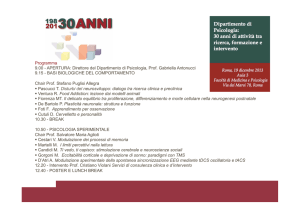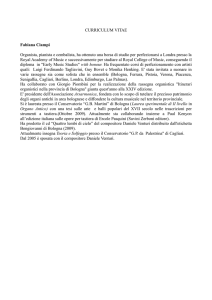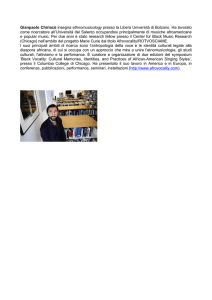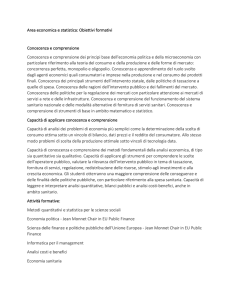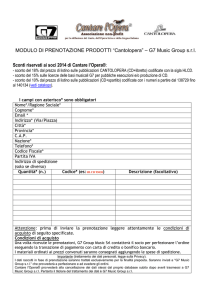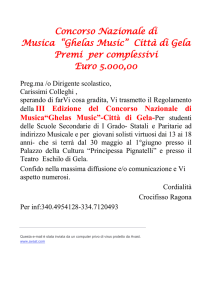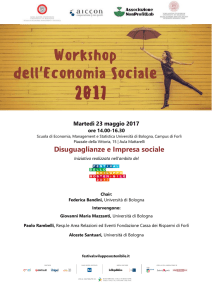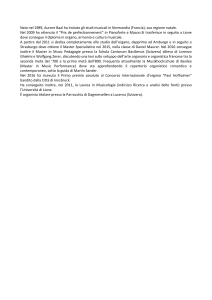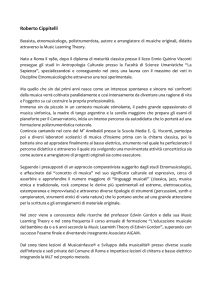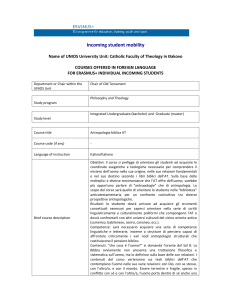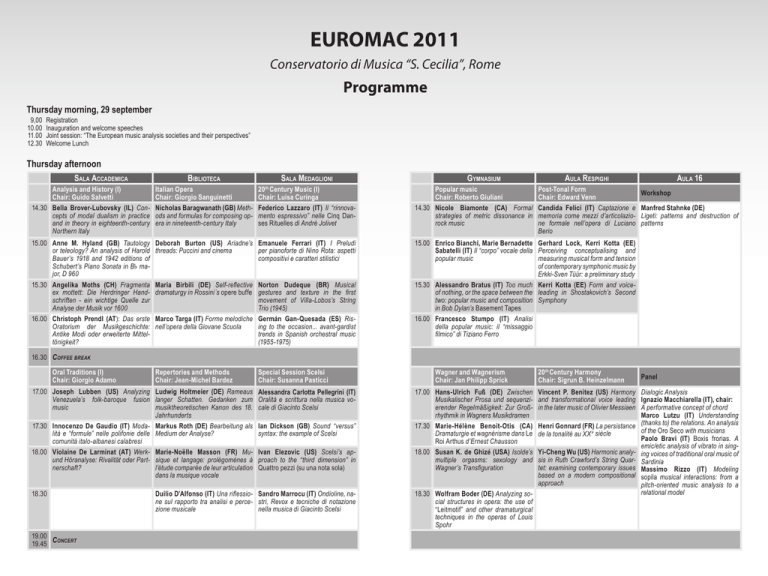
EUROMAC 2011
Conservatorio di Musica “S. Cecilia”, Rome
Programme
Thursday morning, 29 september
9,00
10.00
11.00
12.30
Registration
Inauguration and welcome speeches
Joint session: “The European music analysis societies and their perspectives”
Welcome Lunch
Thursday afternoon
Biblioteca
Sala Medaglioni
Analysis and History (I)
Chair: Guido Salvetti
14.30 Bella Brover-Lubovsky (IL) Concepts of modal dualism in practice
and in theory in eighteenth-century
Northern Italy
Sala Accademica
Italian Opera
Chair: Giorgio Sanguinetti
Nicholas Baragwanath (GB) Methods and formulas for composing opera in nineteenth-century Italy
20th Century Music (I)
Chair: Luisa Curinga
Federico Lazzaro (IT) Il “rinnovamento espressivo” nelle Cinq Danses Rituelles di André Jolivet
15.00 Anne M. Hyland (GB) Tautology
or teleology? An analysis of Harold
Bauer’s 1918 and 1942 editions of
Schubert’s Piano Sonata in B∫ major, D 960
15.30 Angelika Moths (CH) Fragmenta
ex mottett: Die Herdringer Handschriften - ein wichtige Quelle zur
Analyse der Musik vor 1600
16.00 Christoph Prendl (AT): Das erste
Oratorium der Musikgeschichte:
Antike Modi oder erweiterte Mitteltönigkeit?
Deborah Burton (US) Ariadne’s Emanuele Ferrari (IT) I Preludi
threads: Puccini and cinema
per pianoforte di Nino Rota: aspetti
compositivi e caratteri stilistici
Maria Birbili (DE) Self-reflective Norton Dudeque (BR) Musical
dramaturgy in Rossini´s opere buffe gestures and texture in the first
movement of Villa-Lobos’s String
Trio (1945)
Marco Targa (IT) Forme melodiche Germán Gan-Quesada (ES) Risnell’opera della Giovane Scuola
ing to the occasion... avant-gardist
trends in Spanish orchestral music
(1955-1975)
Gymnasium
Popular music
Chair: Roberto Giuliani
14.30 Nicole Biamonte (CA) Formal
strategies of metric dissonance in
rock music
Aula Respighi
Post-Tonal Form
Chair: Edward Venn
Candida Felici (IT) Captazione e
memoria come mezzi d’articolazione formale nell’opera di Luciano
Berio
Aula 16
Workshop
Manfred Stahnke (DE)
Ligeti: patterns and destruction of
patterns
15.00 Enrico Bianchi, Marie Bernadette Gerhard Lock, Kerri Kotta (EE)
Sabatelli (IT) Il “corpo” vocale della Perceiving conceptualising and
popular music
measuring musical form and tension
of contemporary symphonic music by
Erkki-Sven Tüür: a preliminary study
15.30 Alessandro Bratus (IT) Too much Kerri Kotta (EE) Form and voiceof nothing, or the space between the leading in Shostakovich’s Second
two: popular music and composition Symphony
in Bob Dylan’s Basement Tapes
16.00 Francesco Stumpo (IT) Analisi
della popular music: il “missaggio
filmico” di Tiziano Ferro
16.30 Coffee break
Oral Traditions (I)
Chair: Giorgio Adamo
Repertories and Methods
Chair: Jean-Michel Bardez
17.00 Joseph Lubben (US) Analyzing Ludwig Holtmeier (DE) Rameaus
Venezuela’s folk-baroque fusion langer Schatten. Gedanken zum
music
musiktheoretischen Kanon des 18.
Jahrhunderts
17.30 Innocenzo De Gaudio (IT) Moda- Markus Roth (DE) Bearbeitung als
lità e “formule” nelle polifonie delle Medium der Analyse?
comunità italo-albanesi calabresi
18.00 Violaine De Larminat (AT) Werk- Marie-Noëlle Masson (FR) Muund Höranalyse: Rivalität oder Part- sique et langage: prolégomènes à
nerschaft?
l’étude comparée de leur articulation
dans la musique vocale
18.30
19.00
Concert
19.45
Special Session Scelsi
Chair: Susanna Pasticci
Alessandra Carlotta Pellegrini (IT)
Oralità e scrittura nella musica vocale di Giacinto Scelsi
Ian Dickson (GB) Sound “versus”
syntax: the example of Scelsi
Ivan Elezovic (US) Scelsi’s approach to the “third dimension” in
Quattro pezzi (su una nota sola)
Duilio D’Alfonso (IT) Una riflessio- Sandro Marrocu (IT) Ondioline, nane sul rapporto tra analisi e perce- stri, Revox e tecniche di notazione
zione musicale
nella musica di Giacinto Scelsi
Wagner and Wagnerism
Chair: Jan Philipp Sprick
17.00 Hans-Ulrich Fuß (DE) Zwischen
Musikalischer Prosa und sequenzierender Regelmäßigkeit: Zur Großrhythmik in Wagners Musikdramen
17.30 Marie-Hélène Benoit-Otis (CA)
Dramaturgie et wagnérisme dans Le
Roi Arthus d’Ernest Chausson
18.00 Susan K. de Ghizé (USA) Isolde’s
multiple orgasms: sexology and
Wagner’s Transfiguration
20th Century Harmony
Chair: Sigrun B. Heinzelmann
Panel
Vincent P. Benitez (US) Harmony Dialogic Analysis
and transformational voice leading Ignazio Macchiarella (IT), chair:
in the later music of Olivier Messiaen A performative concept of chord
Marco Lutzu (IT) Understanding
Henri Gonnard (FR) La persistance (thanks to) the relations. An analysis
of the Oro Seco with musicians
de la tonalité au XX e siècle
Paolo Bravi (IT) Boxis frorias. A
emic/etic analysis of vibrato in singYi-Cheng Wu (US) Harmonic analy- ing voices of traditional oral music of
sis in Ruth Crawford’s String Quar- Sardinia
tet: examining contemporary issues Massimo Rizzo (IT) Modeling
based on a modern compositional sopila musical interactions: from a
approach
pitch-oriented music analysis to a
relational model
18.30 Wolfram Boder (DE) Analyzing social structures in opera: the use of
“Leitmotif” and other dramaturgical
techniques in the operas of Louis
Spohr
Friday morning, 30 September
Sala Accademica
Biblioteca
Liszt: New Perspectives (I)
Chair: Rossana Dalmonte
9.00 Rossana Dalmonte (IT) Introduzione alle sessioni lisztiane
Analysis and History (II)
Chair: Ludwig Holtmeier
Hans Aerts (DE) Quellen zur Kontrapunktlehre Leonardo Leos: Zur
Musiktheorie in Neapel in der ersten
Serge Gut (FR) L’adaptation de la Hälfte des 18. Jahrhunderts
9.30 forme sonate beethovénienne dans Paolo Sullo (IT) I solfeggi autografi
certaines œuvres du Liszt de la di Nicola Zingarelli nella biblioteca
maturité
San Pietro a Majella di Napoli
Sala Medaglioni
Special Session Scelsi
(cont.) Chair: Nicola Sani
Susanna Pasticci (IT) Improvvisare, comporre, fare musica: i Divertimenti per violino di Giacinto Scelsi
Angela Carone (IT) Scelsi e la
“rivoluzione comportamentale”: il
rapporto tra improvvisazione e composizione nell’ottica della filologia
musicale (con esempi da Hymnos)
10.00 Michael Saffle (US) Liszt’s Sym- Felix Diergarten (DE) (Re-)making Emanuele Del Verme (IT) Scelsi
phonic Poems: past analyses and the cadence dissonant. Remarks on e l’Oriente: l’atto compositivo come
an introduction to meta-analytical the partitura tradition
“veicolo” escatologico
issues
Gymnasium
Aula Respighi
20th Century Music (II)
Syntax and Meter
Chair: Nicola Verzina
Chair: Catello Gallotti
9.00 Sigrun B. Heinzelmann (US) Ra- Roger Mathew Grant (US) Ordnung,
vel’s motivic transformations
Rhythmus, Takt: eighteenth-century
musical temporalities
9.30 Nathalie Ruget (FR) Musique populaire et articulations verbales
dans Le Château de Barbe Bleue
et les six quatuors à cordes de Béla
Bartók: une analyse au crible de la
langue
10.00 Sarah J. Reichardt (US): Sonata
rhetoric and the hermeneutic implications in Dmitri Shostakovich’s
String Quartets
Steven Jan (GB) A memetic analysis of a phrase by Beethoven: Calvinian perspectives on segmentation,
similarity and lexicon-abstraction
Temporality
Chair: Michel Imberty
11.00 Ève Poudrier (US) Multiple temporalities: speeds, beat cues, and beat
tracking in Carter’s instrumental
music
Hermeneutics
Chair: Michael Spitzer
Ildar D. Khannanov (US) Thematicism and form in op. 90 and op. 110:
nostalgia for early italian music in
late Beethoven’s piano sonatas
Aula 16
Workshop
Anne Smith (CH)
16 th century solmization in practice:
What use does it have in the 21st
century?
Martin Küster (DE) Putting measures back on their feet: prosodic
meter beyond Marpurg
10.30 Coffee break
Liszt: New Perspectives (II)
Chair: Laurence Le Diagon-Jacquin
11.00 Frank Heidlberger (US) “Une nouvelle énormité fantastique”: Franz
Liszt’s Grande Fantaisie symphonique on themes from Berlioz’ Lélio
as an experiment in symphonic form
11.30 Jin-Ah Kim (DE) Zyklische Sonatenformkonzeption in Liszts Symphonischen Dichtungen
12.00 Maria Teresa Storino (IT) Liszt and
the piano concerto form: structural
novelty and tradition in the Concerto
n. 2 in A major from the manuscript
sources to the published scores
12.30 Costas Tsougras (GR) Chromatic
third relations, symmetrical octave
division and paths in pitch space:
theoretical and analytical study of
the harmonic structure of Franz
Liszt’s Il Penseroso
13.00
Concert
13.30
Schenker
Chair: Deborah Burton
Egidio Pozzi (IT) Beyond the
“tyranny” of the Urlinie. Enger Satz
and prolongations in the first movement of Franz Joseph Haydn’s
Quartet op. 33 n. 1”
Luciane Beduschi, Nicolas Meeùs
(FR) Vues nouvelles sur la pédagogie de l’analyse schenkérienne:
Schumann’s Träumerei, op. 15 n. 7
Schemata Theories
Chair: Johannes Menke
Claudia J. Scroccaro (IT) Le fughe
per tastiera di Domenico Scarlatti
Gaetano Stella (IT) L’uso degli
“schemi galanti” nella didattica del
contrappunto napoletano: le Regole
del contrappunto pratico di Nicola
Sala
Antonio Cascelli (IE) Schenkerian Juliane Brandes (DE) Fußnote zu
Ursatz and temporal meaning in einem “Essay über verschiedene
Chopin’s Prelude op. 28, n. 5
Schemata in der Musik des galanten
Stils”
Hiroko Nishida (JP) Heinrich Mario Marques Trilha (PT) Il ParSchenker’s verbal associative nar- timento settecentesco in Portogallo
rative and Urlinie narrative
Film Music
Chair: Maurizio Gabrieli
Kevin Clifton (US) Unraveling music in Alfred Hitchcock’s Rope
11.30 Andrew Davis, Corey Tu (US) Sig- Cosima Linke (DE) Eine rätselhafte Olivier Pigott (FR) Mahler: une
nifying temporality in Brahms’s F W Konstellation in Beethovens cis- préfiguration de la narration cinéminor Piano Sonata
Moll-Fuge op. 131, I
matographique
12.00
12.30
Hubert Moßburger (DE) Res oder
“Verba”? Zum historischen Ursprung der Kontroversen über das
Wort-Ton-Verhältnis und seinen
analytisch-hermeneutischen Konsequenzen
Reiko Füting (DE) Composer, poet,
or priest? The ending of Schumann’s
Kinderszenen
Paolo Teodori (IT) Tonalità e non
tonalità nella musica per il cinema;
usi in relazione a contesti ed emozioni
Robert Rabenalt (DE) Music and
Emotion – a music-dramaturgical
study of “affect-formation” in C‘era
una volta il West
Friday afternoon, 30 September
Sala Accademica
Analysis and Performance (I)
Chair: Gaetano Stella
15.00 Mario Baroni, Anna Maria Bordin,
Michela Sacco (IT) From sign to
sound: Analysis of notation with a
view to performance
Biblioteca
Sala Medaglioni
History of Tonal Theory
Chair: Markus Roth
Mart Humal (EE) Contrapuntal
analysis and the history of music
theory
Classical Form
Chair: Giorgio Sanguinetti
Catello Gallotti (IT) The exposition
of the first movement of Beethoven’s E∫ major Piano Sonata, op.
7, between formal functions and
Sonata Theory
15.30 Luca Bruno (IT) Music analysis and
performance: creating an interpretation of Igor Stravinsky’s Piano Sonata (1924), first movement
Nathalie Meidhof (DE) Zwischen
dissonanza, Dissonanz und dissonance. Alexandre Étienne Chorons
(1771-­1834) “europäischer” Akkordbegriff
16.00 Luisa Curinga (IT) Breathing, in- Torsten Mario Augenstein (DE)
terpretation and analysis in the Alle- Falsobordone-settings and vertimande from the J.S. Bach’s Partita cal-thinking in music – studies on
BWV 1030 for solo flute
the technique of the 15th-18 th century falsobordone-practice and its
influence on harmonic setting
Wayne C. Petty (US) “A plan corresponding to the peculiarity of the
subject”: Czerny’s advice on the
development section and its application to Haydn
Patrick Wood Uribe (US) Formenlehre as aesthetic education
Gymnasium
Aula M.E
Liszt: New Perspectives (III)
Chair: Michael Saffle
15.00 Laurence Le Diagon-Jacquin (FR)
Source opératique strophique wagnérienne et adaptation pianistique
lisztienne: l’exemple du Spinnerlied
et de la Ballade de Senta extraits du
Vaisseau fantôme
15.30 Giuliano Danieli, Alexandros
Hatzikiriakos (IT) Liszt e la musica
russa
Aula 16
Electroacoustic Music
Chair: Giorgio Nottoli
Sandrine Lopez-Ferrer (FR) L’analyse de l’espace dans les oeuvres
électroacoustiques multiphoniques
Dack John (GB) Issues in the analysis of Scambi – an “open” electroacoustic composition
16.00 Luigi Verdi (IT) La musica di Franz Renaud Meric (FR) Le faire et
Liszt nel cinema
l’écoute: réflexion sur l’analyse des
musiques informatiques. Autour de
Gymel de Horacio Vaggione
Panel
Analysis, Historiography, and the
Construction of Meaning
Mark Delaere (BE), chair
K. Boucquet (BE) Analyzing history, historicizing analysis. A metamethodological approach
D. Burn, G. McDonald (BE)
Canons and crosses: Leonhard
Paminger’s Vexilla regis prodeunt
and Tua cruce triumphamus
M. Neuwirth, P. Bergé (BE) Fuggir
la cadenza, or The art of avoiding
cadential closure. Contemporaneous vs. modern theoretical perspectives on the analysis of “deceptive
cadences” in the classical repertoire
K. Coulembier (BE) How much theory does music analysis need? The
case of Claus-Steffen Mahnkopf
16.30 Coffee break
Sala Accademica
Music and Emotion
Chair: Mario Baroni
Biblioteca
Baroque Music
Chair: Felix Diergarten
Sala Medaglioni
Liszt: New Perspectives (IV)
Chair: Bruno Moysan
17.00 Melissa Hoag (US) Drama and dis- David Mesquita (CH) Pere Rossana Dalmonte (IT) Franz Liruption in a Brahms Capriccio
Rabassa’s Guia para los principian- szt’s Funérailles among classical
tes und die spanische Musik im frü- forms
hen 18.Jahrhundert
17.30 Michael Spitzer (GB) Analysing Domenico Morgante (IT) La te- Alfonso Alberti (IT) Per un’indagifear in Schubert
atralità del linguaggio tastieristico ne capliniana delle funzioni intratefrescobaldiano
matiche nella produzione matura di
Franz Liszt
18.00 Carlo Bianchi (IT) Ferruccio Buso- Johannes Menke (DE) Analyzing Grace Yu (HK) Interpreting sonata
ni e le emozioni di una rivisitazione Carissimi
form in context: Liszt’s “Dante sobachiana. La Fantasia “in memoria
nata” (1858)
di mio padre Ferdinando”
18.30
19.00
Concert
19.45
Marja Saarela (FI) Example of tonal Panu Heimonen (FI) Sonata form
allegory in Cavalli
deformations in Franz Liszt’s piano
piece Invocation
Gymnasium
Opera in France and Britain
Chair: Nicholas
Baragwanath
17.00 Raphaëlle Legrand (FR)
Baroque architectures:
Jean-Philippe Rameau and
the musico-dramatic structures of French opera
17.30 Caroline Waight (US)
“A great French victory”:
guilt and glory in Francis
Poulenc’s Dialogues of the
Carmelites
18.00 Richard Hermann (US)
Boundaries transgressed:
text setting in Dido’s Lament
18.30 Edward Venn (GB) Musical gesture and dramatic
trajectories: the case of
18.45
Michael Tippett’s The
Knot Garden
Sala Respighi
Late 20th Century Music
Chair: Alessandro
Sbordoni
Bianca Ţiplea Temeş (RO):
Métamorphoses nocturnes,
turning point in Ligeti`s musical texture concept
Aula 6
Workshop
Aula M.E
Workshop
Emanuele Ferrari (IT)
Paolo Bravi (IT)
Réminiscences de Don Doing musicological reJuan by Liszt: dramatic search with Praat
re-write and communication strategies. Piano perClaudio Horacio Vitale formance and analytical
(BR) Processus graduels discussion
dans quelques oeuvres
des annéés soixante et
septante de György Ligetis
Gerardo Scheige (DE)
Klänge des Verstummens.
Zur Konstruktion des Todes in der Musik György
Ligetis
Fabio De Sanctis De
Benedictis (IT) Figura,
processo e articolazione
parametrica in Lumen di Poster
Poster
Franco Donatoni
Elisabetta Piras (IT)
Simonetta Sargenti (IT)
Interpretative choices and Gesture and sound analyanalysis in young pianists’ sis: virtual instruments and
performances
interactive composition
Saturday morning, 1 October
Sala Accademica
Biblioteca
Opera and Stage
Chair: Antonio Rostagno
9.00 Su-yin Mak, Lufan Xu (HK) Musical analysis as stage direction? A
reappraisal the relationship between
analysis and operatic staging
9.30 Marco Stacca (IT) Forme della musica e categorie della regia nel Barbiere di Siviglia secondo Dario Fo
Medieval and Renaissance Music
Chair: Agostino Ziino
Wendelin Bitzan (DE) Neverending canon. Pedagogic approaches
to two-partes canonical passages
from Josquin‘s masses
Marco Mangani, Daniele Sabaino
(IT) L’organizzazione dello spazio
sonoro nella polifonia dell’Ars Nova
Italiana
10.00 Daniele Daude (DE) Gesten - Kno- Paola Ronchetti (IT) Alba cruda,
ten – Korrespondenz
alba ria. Un madrigale di Giovanni
Battista Strozzi attraverso le intonazioni della seconda metà del ‘500
Sala Medaglioni
Gymnasium
Aspects of Tonal Theory
Chair: Wayne Petty
Danuta Mirka (GB) The mystery of
the cadential six-four
Romantic Form
Chair: Antonio Cascelli
9.00 Shigeru Fujita (JP) De Chopin à
Liszt: L’évolution du principe architectonique dans leurs Ballades
Andreas Moraitis (DE) Statistical
correlates of basic tonal relationships
9.30 Konstantin Zenkin (RU) The mobility of structures in the works of Franz
Liszt. From the romantic form-process to “open” form
10.00 Lauri Suurpää (FI): The fourth
piece of Schumann’s Kreisleriana,
op. 16, as a musical fragment: discontinuity and unity intertwined
Uri Rom (DE) Structural deformation as a token of undercurrent humor
in Mozart’s instrumental rondos
Aula M.E
Aula 16
Workshop
Panel
Giovanni Cappiello (IT)
Il paradigma multimediale a supporto della divulgazione musicale: presentazione di tre strumenti software
The induction of emotion in music:
three case studies.
Chelsey Hamm (US), chair: Towards emotional meaning in Ives’s
Orchestral Set No. 2, III
Juan A. Mesa (US)
Hearing emotion in J.S. Bach’s O
Mensch, bewein dein Sünde groß
BWV 622
Katrina Roush (US)
Strong emotions, agency, and the
role of “music alone”: two arias from
Puccini’s Turandot
Aula Respighi
Aula 16
10.30 Coffee break
Sala Accademica
Biblioteca
Sala Medaglioni
Psycoanalitical Issues
Chair: Roberto Caterina
Miloš Zatkalik, Aleksandar Kontić
(RS) Orpheus and Eurydice reunited:
towards a psychoanalytic understanding of “musical affects”
Serialism and Atonality
Chair: Norton Dudeque
Stefanie Acevedo (US) Segmentational approaches of atonal music: a
study based on a general theory of
segmentation for music analysis
11.30 David Clarke (GB) Conditions of Audrey Lavest-Bonnard (FR)
possibility? Ethical and methodolog- Etude du langage schönbergien: un
ical issues in the analysis of North exemple de psychanalyse appliquée
Indian classical music
Johannes Söllner (DE) ZwölftonImprovisation – Zum improvisatorischen Potential der Dodekaphonie
mit Hilfe von hexachordal combinatoriality
Carlos Duque (ES) System, order
and creation in the 4 th Symphony of
Roberto Gerhard: dynamic condition
of chaos
Oral Traditions (II)
Chair: Serena Facci
11.00 Dieter A. Nanz (CH) Between orality and notation. Towards an analysis of Classical Japanese music for
Shakuhachi
12.00 Annie Labussière (FR) Il gesto
vocale come strumento per la valutazione di una struttura profonda
all’interno del canto tradizionale In
naked voice
12.30
13.00
Concert
13.30
Walter Kreyszig (CA) Schönbergs
Lehre vom Zusammenhang und ihre
Auswirkung auf die “Faßlichkeit”
seiner Methode der Komposition mit
zwölf nur aufeinanderbezogenen
Tönen
Gymnasium
Debussy
Chair: Guido Salvetti
11.00 Matthew Brown, John Koslovsky
(US/NL) History and tonal coherence in Debussy’s La fille aux cheveux de lin and Bruyères
Music and Infancy
Chair: Franca Ferrari
Giuseppe Sellari, Giada Matricardi,
Paolo Albiero (IT) The function of
music in the development of empathy in children: the construction
of the educative path “Music and
well-being” and the evaluation of its
effects
11.30 Andrea Malvano (IT) Bipolarismo Johannella Tafuri (IT) Analysis of
armonico ed erotico in Jeux di De- expressive singing in children 2-3
bussy
years old
12.00 Domenico Giannetta (IT) Le transi- Maria Grazia Bellia (IT) Procedizioni modali nella musica di Claude menti compositivi nell’improvvisaDebussy
zione collettiva. Un’esperienza nella
scuola primaria
12.30 Vasilis Kallis (CY) Debussy’s Maria Perri (IT) Analysis of infant
Nuages (Nocturnes, I): ‘tonality’, songs in Europe and China: a compitch material, and issues of inhe- parative study
ritance
Workshop
Jan Ezendam (NL)
Magnus Lindberg Clarinet & Violin
Concerto (2004/2006): Analysis and
comparative study
Saturday afternoon, 1 October
Sala Accademica
Biblioteca
Analysis and Performance (II)
Chair: Laurence Wuidar
15.00 Aurélie Fraboulet Meyer (FR)
Corps, Interprétation et Emotions
Corelli
Chair: Egidio Pozzi
Florian Edler (DE) Zum Verhältnis
von Fugen- und Sequenztechnik in
Arcangelo Corellis “freien“ Instrumental kompositionen
15.30 I. Incasa, E. Fabbri, M. Baroni, R. Ana Lombardía (ES) Mid-18thCaterina (IT) Musical and psycho- century violin sonatas composed in
logical functions of facial expres- Madrid: Corelli’s op. 5 as a model?
sions and body movements in piano
players
16.00 Enrica Fabbri, Fabio Ragazzi, Federico Furnari (IT) Variazioni
Iolanda Incasa, Mario Baroni (IT) sul tema della Follia di Spagna nelle
Styles in performance: comparisons raccolte settecentesche di Tomaso
between two different pieces and Antonio Vitali e Arcangelo Corelli
among seven different performers
Sala Medaglioni
Compositional Processes
Chair: Susanna Pasticci
Susana Kasyan (FR) La notion de
varietas et le processus de composition dans la musique du XVe siècle
Richard McGregor (GB) ‘Active
Agony’ within Wolfgang Rihm’s Tutuguri and the 4th String Quartet
Nena Beretin (AU) Composer/performer collaboration: Elliott Carter
and David Starobin for the guitar
solo Changes (1983)
Gymnasium
Middle Eastern Music
Chair: Ignazio Macchiarella
15.00 Xavier Hascher (FR) Analyse réductive linéaire et monodie modale:
une application à la musique du
Maghreb
15.30 Jean-Claude Charbonnier (FR)
Représentation des systèmes scalaires proche et moyen orientaux
sur touche de luth [abstract not received]
16.00
Aula Respighi
Aula M.E
Hermeneutics II
Workshop
Chair: Ildar Khannanov
Sergio Lanza (IT) Figure retoriche Carlos Agon, Moreno Andreatta (FR)
e musica del XX secolo: indagine Some OpenMusic-based computational models in computer-aided
sulla micronarratività
music theory and analysis
Ana Stefanovic (RS) Strategies of
explicit narration in music drama
Michel Imberty (FR) Émergences
du temps et du sens chez Mallarmé
et Debussy
16.30 Coffee break
Sala Accademica
Analysis and Communication
Chair: Johannella Tafuri
Biblioteca
Timbre and Texture (I)
Chair: Wu Yi Chang
Sala Medaglioni
New Technologies (I)
Chair: Settimio Fiorenzo Palermo
17.00 Jean-Marc Chouvel (FR) L’analyse Violaine de Larminat (FR) Densità
musicale et le problème de la repré- e trasparenza del materiale sonoro
sentation
dell’Opus Number Zoo Nr. 2 (Il Cavallo) di Berio
17.30 Franz Zaunschirm (AT) Harmo- Carlo Benzi (IT) Gesture and “heatnisches Hören auf Melodieinstru- er for the ears” in Visage by Luciano
menten
Berio
Bruno Bossis (FR) La relation
processus/résultat et l’analyse des
musiques avec dispositifs programmables
Fréderic Dufeu (FR) Building analytical tools from digital instruments:
methods and perspectives for program reconstructions in Max/MSP
and SuperCollider
18.00 Roberta De Piccoli (IT): Dai simbo- Yulia Kreinin (IL) Heterophonic tex- Pierre Couprie (FR) Vers de nouli del processo narrativo alle azioni ture since 1945: definition, notation veaux outils multimédias d’aide à
musicali: una forma di comunica- and analysis
l’analyse musicale
zione
18.30
19.00
Concert
19.45
20.00 Social Dinner
Robert C. Cook (US) Timbre and Paula Gomes Ribeiro (PT) Interecology in the music of George faces opéra technologie: les dramaCrumb
turgies de la convergence, Andriessen et Greenaway
Gymnasium
20th Century Compositional Techniques
Chair: Kerri Kotta
17.00 Elisabeth Heil (DE) Intertextuelle
und Intratextuelle Bezüge in Alfred
Schnittkes Peer Gynt – Epilog
Aula Respighi
Analysis and Performance (III)
Chair: Mario Baroni
Aula 6
Workshop
Mine Doğantan-Dack (GB) From Michael Clarke (GB)
performance to form: the second Working with interactive aural analysis
movement of Beethoven’s Piano
Sonata op. 13
17.30 Eva Mantzourani (GB) Nikos Ska- Erica Bisesi, Richard Parncutt (AT)
lkottas’s Largo Sinfonico (1942- How do musical accents induce
44/46/49): Composing with a su- emotions?
perset: unity and diversity in the
construction of the musical space
18.00 William Helmcke (US) Micropoly- Mondher Ayari, Olivier Lartillot (FR)
phonic texture in Górecki’s Sym- L’acte créateur entre culture de
phony n. 3
l’oralité et cognition musicale: Analyse de performance et modélisation
informatique
18.30 Marco Marinoni (IT) La concezione Raffaella Benini (IT) Au lac de Walciclica del tempo musicale in Post- lenstadt di Franz Liszt. Un’analisi
Prae-Ludium N. 1 “per Donau” di per l’interpretazione
Luigi Nono
Sunday morning, 2 October
Sala Accademica
Liszt: New Perspectives (V) Chair:
Rossana Dalmonte
9.00 Bruno Moysan (FR) La pensée
formelle des fantaisies pour piano
de Liszt
Biblioteca
Sala Medaglioni
Renaissance Theory
Chair: Marco Mangani
Robert Bauer (DE) Zwischen Kontrapunkt und Klangfläche – satztechnische Studien zur vollstimmigen
Vokalpolyphonie
Timbre and Texture (II)
Chair: Jean-Marc Chouvel
Iwona Lindstedt (PL) Timbre and
texture as major structural elements: the analysis of early electroacoustic works of W. Kotonski and
A. Dobrowolski in the context of
“sonoristics”
Nicola Verzina (IT) Funzioni macrostrutturali dell’armonia-timbro e della
tessitura: osservazioni analitiche su
alcune composizioni di Ligeti e Maderna negli anni Sessanta
Wai Ling Cheong (HK) Timbre
and texture as sound-colour in the
Gagaku of Messiaen’s Sept Haïkaï
(1962)
9.30 Roberto Scoccimarro (DE) Liszt’s Adriano Giardina (CH) Formes
late Lieder production (1862-1886): et fonctions des cadences dans
reworkings, new settings
quelques motets de Roland de Lassus
10.00 Ida Zicari (IT) Relationships between Jeremy Grall (US) The roles of
music and dance. A case study on sender and receiver and musical
Liszt’s Sonata in B minor
signification within sixteenth-century
improvisation
11.00 Plenary session: Music analysis tomorrow. New perspectives – new repertoires – new theories
13.00 Speakers: Pieter Bergé, Richard Parncutt, Giorgio Sanguinetti, Philip Tagg
Sunday afternoon, 2 October
Executive meeting of the delegates of the European Music Analysis Societies
Gymnasium
Aula M.E
New Technologies (II)
Panel
Chair Bruno Bossis
9.00 The Boundaries of the Spectral Sub- Maurizio Gabrieli (IT) ScoreSifter:
ject: temporality, vernacular music software for analysis of post-tonal
and the solo viola in the music of music using domain-based segmenGrisey, Radulescu and Ligeti
tation
Aula 16
Panel (Round Table)
Storicità e trascendenza della logica
musicale
Mauro Mastropasqua (IT), chair
Paolo Cecchi (IT)
Amy Bauer (US), chair :
Maurizio Giani (IT)
9.30 Viola as the spectral subject of con- Olivier Lartillot (FR) A computa- Andrea Lanza (IT)
temporary music
tional framework for comprehensive
Huey-Meei Chen (US) Process and motivic analysis based on a cognitive
temporality in Grisey’s music
modelling
Liviu Marinescu (US) Horatiu Radulescu and the primordial sounds
10.00 of Romania
Damien Sagrillo (LU) Scales, melodic traits and forms in German folksongs. Automated folksong analysis
by EsAC

